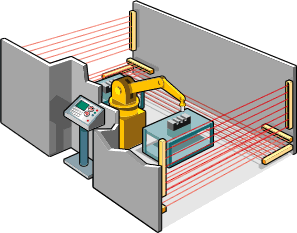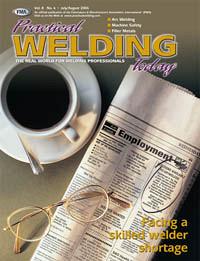Contributing Writer
- FMA
- The Fabricator
- FABTECH
- Canadian Metalworking
Categories
- Additive Manufacturing
- Aluminum Welding
- Arc Welding
- Assembly and Joining
- Automation and Robotics
- Bending and Forming
- Consumables
- Cutting and Weld Prep
- Electric Vehicles
- En Español
- Finishing
- Hydroforming
- Laser Cutting
- Laser Welding
- Machining
- Manufacturing Software
- Materials Handling
- Metals/Materials
- Oxyfuel Cutting
- Plasma Cutting
- Power Tools
- Punching and Other Holemaking
- Roll Forming
- Safety
- Sawing
- Shearing
- Shop Management
- Testing and Measuring
- Tube and Pipe Fabrication
- Tube and Pipe Production
- Waterjet Cutting
Industry Directory
Webcasts
Podcasts
FAB 40
Advertise
Subscribe
Account Login
Search
Playing it safe with robotic welding
How machine-safeguarding equipment can protect robots and operators
- By Sergio Aguilar
- August 10, 2004
- Article
- Automation and Robotics
 |
| This robotic welding workcell is guarded on all four sides. The back of the workcell uses the control panel and hard guards to prevent entry to the safeguarded space. The wall must be high enough to ensure that no one can reach over it into the protected area. |
In 2002 the Robotic Industries Association (RIA) estimated that nearly half of all robots (total installed base of 126,000) are used as welders on the plant floor. Although costly, they deliver consistent welds while tolerating smoke, sparks, and light from intense weld arcs. They also can reduce human exposure to these dangers.
In spite of these capabilities, the average robot isn't intelligent, can't perform without some level of human intervention, and isn't integrated easily with other machinery. As a result, machines, robots, and personnel need to be protected from one another while maintaining productivity and throughput.
Confronting Safety Obstacles
Arc and spot welding applications generate a challenging environment that includes hot particles, smoke, dust, intense light flashes, electric surges that affect power line quality, and electromagnetic interference (EMI) that can be detrimental to nearby equipment and machinery. Consequently, in robotic welding applications, users must consider a number of issues as they foster and develop a safe and productive working environment.
The ANSI/RIA R15.06-1999 reference standard states: "A safety system must enclose the work area and all its machinery such that the robot is able to function unencumbered." This means the first issue to address is to define the robot or robotic system and its envelope of operation. Robots use power supplies, end effectors, control systems, part-holding jigs, and other supporting equipment. These pieces of equipment define the minimum area that comprises the robotic system's operating envelope. This envelope also can include the space occupied by additional equipment and the operators needed to monitor, feed, and remove parts during operations.
Know the Risks. For a robotic welding system to work properly, machine-safeguarding equipment must be chosen using a rigorous and formal risk assessment that considers all potential hazards and hazard-guarding solutions. Machine users should refer to ANSI B11.TR3, ANSI/RIA R15.06-1999, and EN1050 for guidance before starting a formal assessment process.
While a detailed explanation of the risk assessment process is beyond the scope of this article, one particular point related to robots is significant. Robots make rapid and wide-reaching moves. The goal is to stop a robot before it can hurt someone. As a result, the RIA has developed a means of calculating safety distance, which typically is used in regard to the installation of safety mats.
Any robot that moves more that 10 inches per second must be safeguarded adequately. Safe distance is determined by the following formula with the following parameters:
- DS= 63 inches per second (IPS) X(TS+ TC+ TR) + DPF
- DPF= 1.2 m (48 in.)
Where:
- DS= minimum safe distance
- TS= stopping time of device
- TC= worst stopping time of control system
- TR= response time of safeguarding device including interface
- DPF= maximum travel distance toward a hazard once someone has entered the field
So the total horizontal space to be protected is 48 in. plus 63 IPS, multiplied by the total time delay between detection of a person in the protected area and the actual time it takes for the robot to stop.
 |
| Figure 1 Safety interlock switches are a safeguarding option for robotic welding workcells that typically work in concert with barrier guards to protect infrequently accessed areas that require entry for periodic maintenance or repair. |
Types of Safety Devices
Once the workspace has been defined and a risk assessment has been performed, the user must specify the best safety equipment based on application requirements and user activity. A number of safeguarding options are available for robotic welding applications that often work together to provide a complete system.
Mechanical Barriers. Mechanical barriers, or "hard" guards, such as doors and gates, may make up one or two walls of a robotic workcell to prevent access to a specific area (see Figure 1).
The barrier guard is interlocked to the power source of the hazard to ensure that when the guard door or gate is open, power to the robot welder and adjacent machinery is switched off. The control of the robot's power source is routed through the safety contacts of the interlock switch or its safety monitoring relay. When a barrier guard is opened, the interlock switch or relay isolates the robot's power supply.
Some interlock switches also incorporate a locking device that locks the barrier guard closed and won't release it until the robot is in a safe condition. In many welding applications the combination of a movable guard with an interlock switch is a key part of reliable and cost-effective guarding.
 |
| Figure 2 For robotic workcells that require frequent access, control-reliable safety devices can prevent dangerous motion, while allowing unrestricted access to the cell. |
When frequent access to the workcell is required, physical guards may be too restrictive for parts loading and adjustment. These areas of the robotic workcell demand control-reliable safety devices that prevent dangerous motion, while allowing unrestricted access to the cell (see Figure 2).
Safety Light Curtains. Safety light curtains use infrared light beams to detect when a person or object has entered or exited the workcell space. These devices can deliver a flexible combination of safeguarding and accessibility in robotic welding applications and are immune to smoke, dust, particulate matter, and ambient light sources such as welding flash. They can provide easy access to the robotic workcell for placing and removing parts, while keeping workers and other machinery protected from the robot. Safety light curtains can be used as a perimeter guard or point-of-operation guard.
As a perimeter guard, a safety light curtain detects anyone or anything entering the robot's work envelope and stops the robot immediately. In this situation, the robotic workcell can't be reactivated until it has been cleared for operation by personnel at an outside station with a clear view of all areas of the workcell (see Figure 3).
 |
| Figure 3 A safety light curtain detects anyone or anything entering the robot's work envelope and stops the robot. This robotic workcell must be cleared for operation by someone at an outside station with a clear view of all the workcell's areas before it can be reactivated. |
Area Scanning Devices. Area scanning devices usually use laser light to guard a robotic workcell. When properly programmed, area scanners detect an intrusion into the defined area, and they can be reprogrammed if the configuration of the workcell changes.
Additionally, area scanning devices frequently include a programmable "warning zone," which can be set to warn an operator against entering the workcell without stopping the robot first. Intruding farther into the zone will block the safety zone and stop the robot.
Safety Mats. Safety mats are another machine-guarding option. They're often installed for robotic applications as a secondary safety system for guarding the workcell. When someone steps onto a safety mat, a signal is sent to the controller, stopping or preventing the start-up of the robot.
Protecting Safety Equipment
Another important consideration in robotic welding applications is that electrical line surges and welding arcs can wreak havoc on electronic equipment. Users therefore need to isolate safety equipment power supplies and shield them from electrical arcs.
Error-prone or inoperative safety equipment is worse than no safety equipment at all. Improperly operating safety equipment frustrates workers and, more important, leads to a false sense of security. It's crucial that personnel responsible for machine safeguarding take an active interest in the maintenance of the safeguards.
It's imperative that the entire robotic workcell area and all aspects of machine use be identified and considered when selecting and implementing a safety system. Ultimately, the best type of protective measure will be the device or system that provides maximum protection, with minimal impact on normal machine operation.
Sergio Aguilar is product manager at Scientific Technologies Inc., 6550 Dumbarton Circle, Fremont, CA 94555, 800-479-3658 or 510-608-3400, fax 510-744-1442, fax back system 916-431-6544, sales@sti.com, www.sti.com.
- American National Standards Institute, www.ansi.org
- Robotic Industries Association, www.ria.org
About the Author
About the Publication
Related Companies
subscribe now

The Welder, formerly known as Practical Welding Today, is a showcase of the real people who make the products we use and work with every day. This magazine has served the welding community in North America well for more than 20 years.
start your free subscription- Stay connected from anywhere

Easily access valuable industry resources now with full access to the digital edition of The Fabricator.

Easily access valuable industry resources now with full access to the digital edition of The Welder.

Easily access valuable industry resources now with full access to the digital edition of The Tube and Pipe Journal.
- Podcasting
- Podcast:
- The Fabricator Podcast
- Published:
- 04/16/2024
- Running Time:
- 63:29
In this episode of The Fabricator Podcast, Caleb Chamberlain, co-founder and CEO of OSH Cut, discusses his company’s...
- Industry Events
16th Annual Safety Conference
- April 30 - May 1, 2024
- Elgin,
Pipe and Tube Conference
- May 21 - 22, 2024
- Omaha, NE
World-Class Roll Forming Workshop
- June 5 - 6, 2024
- Louisville, KY
Advanced Laser Application Workshop
- June 25 - 27, 2024
- Novi, MI































